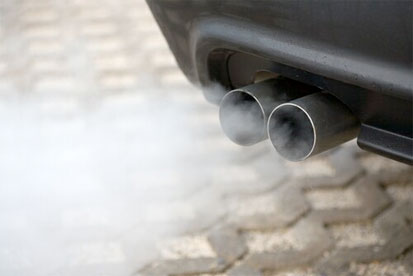Blog Post
Just Say No to Idling

The easiest energy savings come from little changes in our behavior that don't cause any hardship--or even result in ancillary benefits. Such is the case with reducing the amount of time spent idling a car engine when stopped. Turning off the ignition at the drive-up window or when pulled over to take a cell phone call not only saves energy (burning less gasoline), but also pollutes less--a big benefit for the teller at the drive-up bank window. You might even improve your car's operation.
Average drivers in America idle five to ten minutes per day--sitting at traffic lights, warming up the car in the morning, waiting at the drive-up McDonalds, or picking up the kids at the bus stop. This is "voluntary idling"--as opposed to the idling that occurs in traffic congestion. Idling ten minutes per day wastes about 30 gallons of gas per year. Collectively, Americans consume about 3.8 million gallons of gasoline per day from voluntary idling.
Idling vehicles are heavy polluters. The U.S. Environmental Protection Agency (EPA) estimates that an average car emits 20 times more air pollution when idling than it does when being driven at 32 miles per hour. Idling a medium-sized car just five minutes each day will crank out about 30 pounds of harmful pollutants in a year plus 300 pounds of carbon dioxide.
Some of these compounds are pretty potent. EPA estimates that air toxins emitted by vehicles cause half of all cancers attributed to outdoor sources of air pollutants in the U.S. Idling diesel vehicles are particularly problematic due to the very small particulates and some 40 chemicals emitted from the exhaust that are classified as "hazardous air pollutants" under the Clean Air Act. Because children are particularly vulnerable to hazardous chemicals, idling of school busses has been targeted by health activists in communities throughout the country, including locally.
There are a number of myths about idling:
Myth 1: Cars should idle for several minutes before being driven. Unless you have an old car with a carbureted engine, this myth is wrong except in extremely cold weather. Modern engines need no more than 30 seconds of operation to circulate engine oil before being safely driven (though it's best to avoid hard acceleration until the car is fully warmed up).
SUPPORT INDEPENDENT SUSTAINABILITY REPORTING
BuildingGreen relies on our premium members, not on advertisers. Help make our work possible.
See membership options »Myth 2: Each time you turn off and then restart a car you waste more energy than if you leave it idling. Studies show that the actual "break-even" point for turning off a car is between six and ten seconds. In other words, if you're going to be stopped for more than ten seconds, it makes sense to turn off the ignition.
Myth 3: Repeatedly restarting a car is hard on the engine and quickly drains the battery. There is slight wear on the starter motor and some battery discharge that occurs, but this is minor. The savings from burning less gasoline pay back that added maintenance cost many-fold over the course of a year. In fact, idling a car forces the engine to operate in an inefficient, gasoline-rich mode that can reduce performance and degrade mileage.
At least 17 states currently have some form of statewide restrictions on idling, including all New England states...except Vermont--plus some states not known for environmental leadership, such as Nevada, South Carolina, and Utah. This is pretty embarrassing for a state often considered the greenest in the country!
In addition to these statewide laws, many municipalities have their own rules--some of which are significantly stricter than relevant state regulations. Locally, Putney has adopted an anti-idling ordinance.
These state and municipal regulations vary dramatically--as does enforcement. New York City, for example, has one of the strictest no-idling regulations in the country (limiting idling to three minutes with various exceptions and with increasingly heavy fines for first, second, and third offenses)--yet one certainly sees a lot of trucks idling in the Big Apple.
New technologies can also help reduce unnecessary idling. Hybrid cars have a feature that automatically turns the engine off when stopped (though that function only works in our Honda when the fan is turned off). We could make it easier for non-hybrid drivers to know when to turn the ignition off by installing traffic lights that count down the number of seconds remaining for the red light--thus helping drivers figure out whether to turn off the ignition while waiting.
Published November 23, 2009 Permalink Citation
(2009, November 23). Just Say No to Idling. Retrieved from https://www.buildinggreen.com/blog/just-say-no-idling



Add new comment
To post a comment, you need to register for a BuildingGreen Basic membership (free) or login to your existing profile.